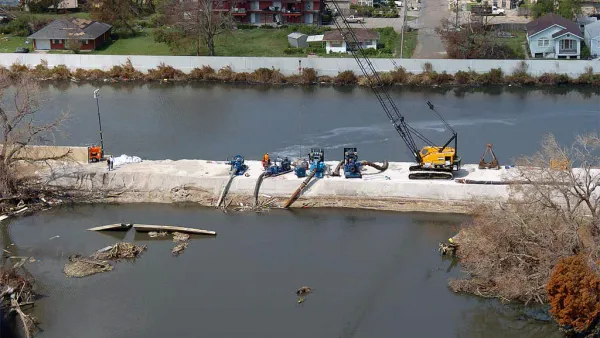The Times-Picayune reports that the Army Corps of Engineers, under pressure from penny-pinched local governments, has commenced a new pilot study that potentially relaxes the new, stricter standards for levees it set in place post-Katrina.
The Army Corps of Engineers has embarked on a new study in southern Louisiana that could eventually lead to more levee design and construction alternatives for municipalities in the region. The action raises questions about the most cost-effective types of levees and protection for coastal communities threatened by flooding from volatile weather and nearby bodies of water.
Local governments in the area saw costs rise dramatically when, in response to Hurricane Katrina, the corps developed new regulations mandating that levees protect threatened communities from 100-year storms. These are storms that have a one percent chance of occurring in a given year. If it is successful, the new corps study, formally titled the "Risk Based Criteria Optimization Study," may give communities the option to choose lesser, less expensive levels of protection. A wider array of less-protective levee options would potentially save the governments significant amounts of money and lessen a hefty financial burden that stems from the current requirement that state and local government pay 35 percent of the cost of levee construction.
Many academics and experts are concerned that relaxed flood protection standards and the acceptance of a higher flood risk would be a step in the wrong direction for threatened communities. The proposal has its fair share of critics, including those who believe that it places too much emphasis on the overtopping of levees by storm surge as the principal component of levee failure:
"Ray Seed, a civil engineering professor at the University of California at Berkeley, said the pilot study plan is flawed because it may not adequately consider some of the causes of levee failures in New Orleans, such as floodwaters seeping underneath earthen levees, causing them to collapse or move."
FULL STORY: Sturdier levee standards at risk

National Parks Layoffs Will Cause Communities to Lose Billions
Thousands of essential park workers were laid off this week, just before the busy spring break season.

Retro-silient?: America’s First “Eco-burb,” The Woodlands Turns 50
A master-planned community north of Houston offers lessons on green infrastructure and resilient design, but falls short of its founder’s lofty affordability and walkability goals.

Delivering for America Plan Will Downgrade Mail Service in at Least 49.5 Percent of Zip Codes
Republican and Democrat lawmakers criticize the plan for its disproportionate negative impact on rural communities.

Test News Post 1
This is a summary

Test News Headline 46
Test for the image on the front page.

Balancing Bombs and Butterflies: How the National Guard Protects a Rare Species
The National Guard at Fort Indiantown Gap uses GIS technology and land management strategies to balance military training with conservation efforts, ensuring the survival of the rare eastern regal fritillary butterfly.
Urban Design for Planners 1: Software Tools
This six-course series explores essential urban design concepts using open source software and equips planners with the tools they need to participate fully in the urban design process.
Planning for Universal Design
Learn the tools for implementing Universal Design in planning regulations.
EMC Planning Group, Inc.
Planetizen
Planetizen
Mpact (formerly Rail~Volution)
Great Falls Development Authority, Inc.
HUDs Office of Policy Development and Research
NYU Wagner Graduate School of Public Service



























